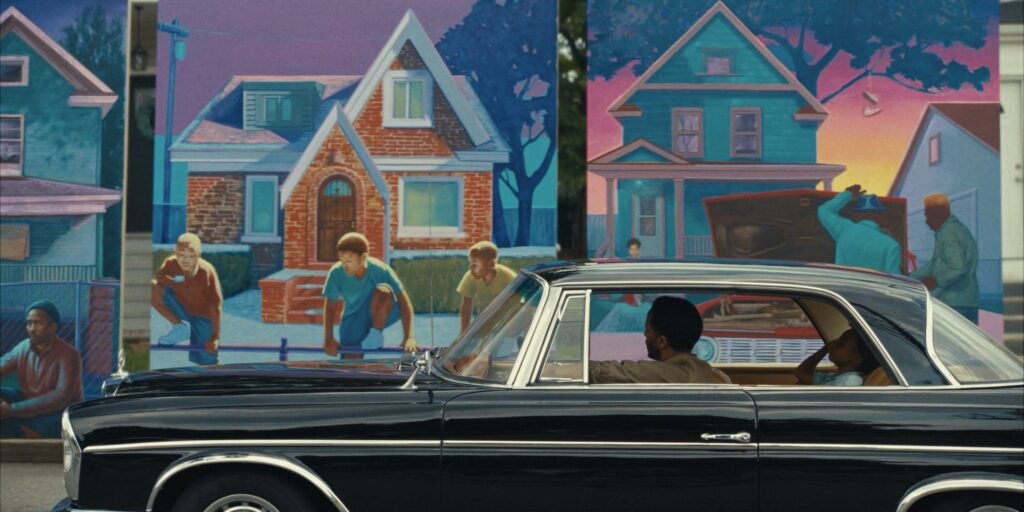“Exhibiting Forgiveness”, the directorial debut of celebrated painter Titus Kaphar, delivers a poignant exploration of familial trauma, addiction, and the elusive nature of forgiveness. Premiering at the Sundance Film Festival in 2024, the film stars André Holland as Tarrell Rodin, a successful painter who uses art as a means to grapple with his painful past. The story follows Tarrell’s life as he faces an unexpected reunion with his estranged father, La’Ron (played by John Earl Jelks), a recovering addict seeking redemption.
The narrative is set against the backdrop of Tarrell’s affluent life with his wife, Aisha (Andra Day), a singer-songwriter, and their young son, Jermaine. Despite outward appearances, Tarrell’s unresolved trauma manifests through frequent panic attacks and tension with his family. His art—beautiful, yet deeply influenced by the anguish of his past—serves as a coping mechanism, allowing him to confront his demons without addressing them directly. This artistic expression becomes both a reflection of his inner turmoil and a barrier that isolates him from those who don’t understand his pain.
When La’Ron re-enters his life, brought back by Tarrell’s well-meaning mother Joyce (Aunjanue Ellis-Taylor), the story takes a turn into raw emotional territory. Tarrell’s initial reaction is one of rage and rejection, unable to forgive a man who once inflicted so much suffering on him and his mother. As the two men struggle to reconcile, the film asks profound questions about the nature of forgiveness: Is it necessary for healing? Can some wounds ever truly be healed? And what does it mean to seek forgiveness without explicitly asking for it?
André Holland’s Masterful Performance
Holland’s portrayal of Tarrell is both riveting and devastating. His performance captures the complexities of a man who is both victim and survivor, channeling his pain into art while grappling with the prospect of forgiveness. Critics have praised Holland for the depth he brings to the role, delivering a performance that is raw and nuanced. Rodrigo Perez of *The Playlist* describes his portrayal as “electrifying,” noting that Holland embodies the character’s anger, pain, and eventual confrontation with his past in a way that leaves the audience questioning their own capacity for forgiveness.
John Earl Jelks as La’Ron also delivers a compelling performance, portraying a man who, despite his history of addiction and neglect, genuinely yearns for redemption. The dynamic between Holland and Jelks is intense, with each scene between father and son brimming with unspoken emotions and unresolved tensions. Aunjanue Ellis-Taylor’s portrayal of Joyce adds another layer of complexity, as she acts as the bridge between the two men, struggling to maintain her own sense of peace while hoping to mend their fractured relationship.
The Role of Art in *Exhibiting Forgiveness*
Kaphar’s background as a painter is evident throughout the film, not just in the aesthetic choices but in the way art is woven into the narrative itself. Tarrell’s artwork—provided by Kaphar—serves as a visual representation of his trauma. Each brushstroke and color choice is laden with meaning, conveying emotions that Tarrell cannot articulate in words. His work becomes a medium through which he both expresses and shields himself from his memories.
The film’s cinematography by Lachlan Milne (known for *Minari*) captures the dual nature of Tarrell’s art: both beautiful and haunting. One particularly striking scene involves a collaboration between Tarrell and Aisha, where she sings a new song as he suggests adding the color yellow to his latest painting. The interplay between sound and color highlights the synergy between their different artistic disciplines and underscores the emotional support they provide one another, even as Tarrell’s unresolved issues begin to unravel their harmony.
Themes of Trauma, Forgiveness, and Reconciliation
The central theme of “Exhibiting Forgiveness” is the struggle to forgive and the question of whether forgiveness is even possible when the damage is so severe. As critics have pointed out, the film does not offer easy answers. Instead, it presents the viewer with a complex portrait of generational trauma, showing how the sins of the father are passed down and how breaking that cycle requires confronting one’s past head-on.
The film also explores the idea of forgiveness as an internal journey. Tarrell’s refusal to forgive his father is portrayed not just as a response to La’Ron’s actions, but as a reflection of his own internalized pain and inability to move forward. The film suggests that forgiveness is not merely about letting go of anger, but about confronting the pain and learning to live with it—an idea captured in a poignant scene where Tarrell revisits a pool from his childhood, now abandoned and overgrown. He sees not the nostalgic memories of youth but the cracks in the paint, symbolic of his fragmented sense of self.
Titus Kaphar’s Directorial Vision
Titus Kaphar’s directorial debut is a triumph of storytelling and visual artistry. The film’s structure often breaks from conventional narrative flows, with flashbacks and dream sequences that illustrate the psychological impact of Tarrell’s trauma. These moments disrupt the viewer’s sense of time and place, mirroring Tarrell’s own disjointed experience of reality. Kaphar’s decision to include his own paintings in the film further blurs the line between fiction and reality, making “Exhibiting Forgiveness” not just a movie but an extension of his artistic practice.
The film has garnered critical acclaim for its unflinching portrayal of pain and the nuanced performances of its cast. TheWrap’s review praised it as an “emotionally fraught” and “boldly conceived” work that “confronts the multigenerational impact of addiction and abuse” (TheWrap). Meanwhile, “The Playlist” described it as a “devastating portrait” that leaves the audience questioning the nature of familial bonds and the limits of forgiveness (The Playlist).
“Exhibiting Forgiveness” is not an easy film to watch, but it is a deeply rewarding one. It challenges its audience to grapple with uncomfortable truths about family, trauma, and the long shadow of generational pain. With masterful performances from André Holland, John Earl Jelks, and Aunjanue Ellis-Taylor, the film’s emotional intensity is palpable and unrelenting. As Titus Kaphar’s first foray into filmmaking, “Exhibiting Forgiveness” establishes him as a powerful storyteller who is unafraid to delve into the darkest corners of the human experience.
For viewers seeking a film that resonates on both an intellectual and emotional level,”Exhibiting Forgiveness” is a must-see. It is a testament to the power of art to both reflect and transform our understanding of the world and ourselves.
No comments yet.








